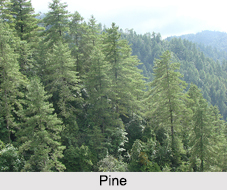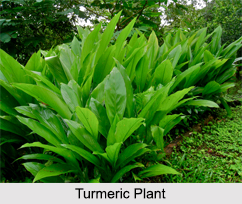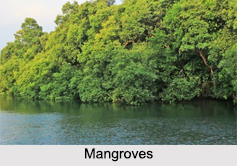 Flora of India comprises of a wide variety of indigenous or native plant types. India is located at the junction of the three major bio-geographic realms namely, the Indo-Malayan, the Eurasian and the Afro-tropical. It is the seventh largest country in the world and the second largest in Asia. India is considered to be one of the twelve centers of origin of several plant species in the world. The rich floral diversity of India is undoubtedly due to the vast variety of climatic and altitudinal variations coupled with varied ecological habitats. India has almost rainless areas as well as area receiving highest rainfall in the world. The altitude varies from sea level to high mountain ranges. The habitat types range from humid tropical Western Ghats to Thar Desert of Rajasthan and from cold desert of Ladakh and icy mountains of the Himalayas to the long and warm coast line stretches of peninsular India. This extreme diversity has resulted in luxuriant and variety in flora and fauna of India.
Flora of India comprises of a wide variety of indigenous or native plant types. India is located at the junction of the three major bio-geographic realms namely, the Indo-Malayan, the Eurasian and the Afro-tropical. It is the seventh largest country in the world and the second largest in Asia. India is considered to be one of the twelve centers of origin of several plant species in the world. The rich floral diversity of India is undoubtedly due to the vast variety of climatic and altitudinal variations coupled with varied ecological habitats. India has almost rainless areas as well as area receiving highest rainfall in the world. The altitude varies from sea level to high mountain ranges. The habitat types range from humid tropical Western Ghats to Thar Desert of Rajasthan and from cold desert of Ladakh and icy mountains of the Himalayas to the long and warm coast line stretches of peninsular India. This extreme diversity has resulted in luxuriant and variety in flora and fauna of India.
Estimated Flora in India
The types of flora in India are in accordance with the topography of the land. According to the World Conservation Monitoring Centre (WCMC), 1,604,000 species have been estimated at the global level. India accounts for about 8 percent of the global biodiversity, which covers about 2.4 percent of the land area of the world. The number of flowering plant species in India is over 16,000. Hajra and Mudgal (1997) had reported about 5400 endemic species, among 17000 angiospermous species of India, which comes to 31.76 percent. India is an important center of agro-biodiversity. It has contributed about 167 species to the world agriculture. It serves as a home to about 320 species of wild relatives of crops. Almost all types of forests ranging from scrub forest to the tropical evergreen rain forest and from coastal mangrove to the temperate and alpine flora occur in India. The tropical moist deciduous forest forms the major percentage of forest cover in India (almost 37 percent). Tropical dry deciduous forest rank second.
Distribution of Flora of India
In terms of physical geography, the mainland of India can be divided into six distinct regions namely, the Himalayas, the Indo-Gangetic Plain and the Peninsular India, the Thar Desert, the Coastal Plains and the Indian Islands. Different types of flora are present in these regions. The physiographic divisions of India and the flora in these divisions are described below.
Indian Flora in Himalayas
Himalayas form a mountain chain along the extreme northern margins of India. It extends in an east-west direction for a length of about 2,400 km. Its width ranges from 400 kilometers in the west to 150 kilometers in the east. It occupies an area of about 500,000 square kilometers in India. Geographically, the Himalayas range from the low-lying Indian plains to the highest mountain peak in India namely, Kanchenjunga in Sikkim. In the Himalayan region, the natural vegetation varies with altitude. Inner Himalayas is rich in chilgoza, oak, maple and ash. In the eastern Himalayan region oaks, laurels, maples, rhododendrons, etc are found. Western Himalayas has conifers like pine. In the north-western Himalayas chir pine are known to grow (except in Kashmir). In the foothills of Himalayas deciduous trees, shrubs, fern and grass can be found.
Indian Flora in Indo-Gangetic Plain
Indo-Gangetic Plain extending from Punjab to Assam comprises of alluvial lowlands lying parallel to the south of the Himalayas. This region is agriculturally very productive and is used to grow crops like wheat and rice. Some of the floral species of this region are soap pod, neem, golden leatherfern, mangrove fern, common turmeric, mahua, Indian sandalwood, white sandalwood and ashoka.
Flora in Peninsular India
Peninsular India comprising of the Central Highlands, Deccan Plateau, Eastern Ghats and Western Ghats, lies south of the Indo-Gangetic plain, the two being roughly separated by the Tropic of Cancer. Along the Western Ghats, deciduous forests are present. In the interior of the Deccan plateau, tropical dry forests and scrublands can be found. South Western Ghats montane rain forests are present in southern Western Ghats at higher elevations. In the dry Telengana plateau, thorny scrub and wild Indian date palm are present.
Indian Flora in Thar Desert
Thar Desert is located in northwestern India. The sweltering heat of the sun in this region is responsible for short, stout and underdeveloped trees. Northwestern thorn scrub forest can be found here. Some of the floral species of Thar Desert are Acacia Jacquemontii, Euphorbia Neriifolia, Balanites Roxburghii, Ochthochloa Compressa and Ziziphus Zizyphus.
Indian Flora in Coastal Plains
Coastal Plains are located to the east and west of the peninsular plateau of India. Coastal Plains are divided into the western coastal plain and the eastern coastal plain. The width of the western coastal plain ranges from 10 to 15 km, whereas the width of the eastern coastal plain ranges from 50 to 60 km. Malabar coast moist forests, mangroves, etc beautify the coastal plains of India.
Indian Flora on Islands
There are about 1,208 Indian Islands. The main groups of islands of India are the Lakshawadeep in the Arabian Sea and the Andaman and Nicobar Islands in the Bay of Bengal.
The flora of Lakshawadeep comprises of coconut tree, banana tree, species like Scaevola Koenigii, Calophyllum Inophyllum, etc. The flora of Andaman Islands comprises of moist deciduous forests, woody climbers, mangroves, timber, etc.











